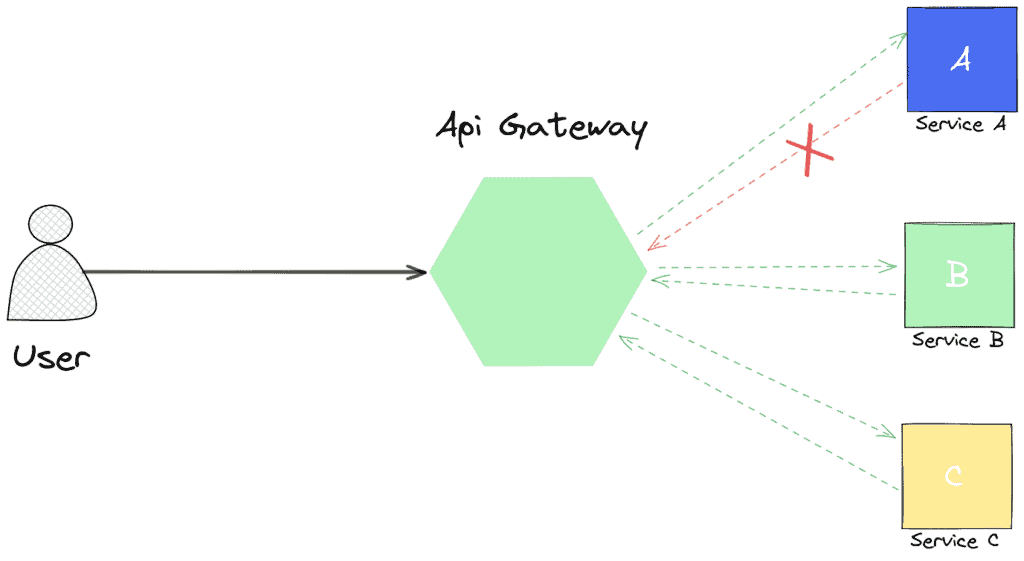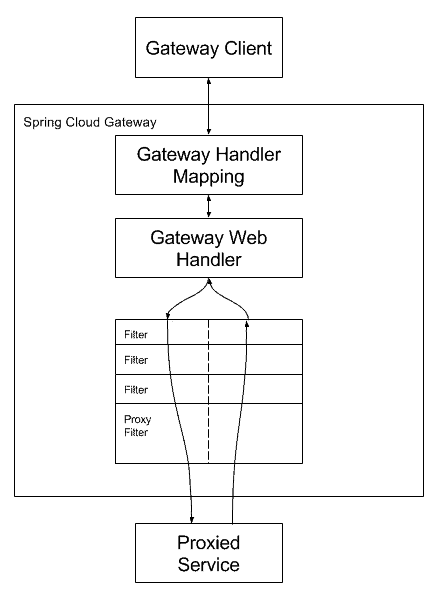1. Overview
In this tutorial, we’ll explore the nuances of implementing a global exception-handling strategy within Spring Cloud Gateway, delving into its technicalities and best practices.
In modern software development, especially in microservices, efficient management of APIs is crucial. This is where Spring Cloud Gateway plays an important role as a key component of the Spring ecosystem. It acts like a gatekeeper, directing traffic and requests to the appropriate microservices and providing cross-cutting concerns, such as security, monitoring/metrics, and resiliency.
However, in such a complex environment, the certainty of exceptions due to network failures, service downtime, or application bugs demands a robust exception-handling mechanism. The global exception handling in Spring Cloud Gateway ensures a consistent approach for error handling across all services and enhances the entire system’s resilience and reliability.
2. The Need for Global Exception Handling
Spring Cloud Gateway is a project part of the Spring ecosystem, designed to serve as an API gateway in microservices architectures, and its main role is to route requests to the appropriate microservices based on pre-established rules. The Gateway provides functionalities like security (authentication and authorization), monitoring, and resilience (circuit breakers). By handling requests and directing them to appropriate backend services, it effectively manages cross-cutting concerns like security and traffic management.
In distributed systems like microservices, exceptions may arise from multiple sources, such as network issues, service unavailability, downstream service errors, and application-level bugs, which are common culprits. In such environments, handling exceptions in a localized manner (i.e., within each service) can lead to fragmented and inconsistent error handling. This inconsistency can make debugging cumbersome and degrade the user’s experience:
Global exception handling addresses this challenge by providing a centralized exception management mechanism that ensures that all exceptions, regardless of their source, are processed consistently, providing standardized error responses.
This consistency is critical for system resilience, simplifying error tracking and analysis. It also enhances the user’s experience by providing a precise and consistent error format, helping users understand what went wrong.
3. Implementing Global Exception Handling in Spring Cloud Gateway
Implementing global exception handling in Spring Cloud Gateway involves several critical steps, each ensuring a robust and efficient error management system.
3.1. Creating a Custom Global Exception Handler
A global exception handler is essential for catching and handling exceptions that occur anywhere within the Gateway. To do that, we need to extend AbstractErrorWebExceptionHandler and add it to the Spring context. By doing so, we create a centralized handler that intercepts all exceptions.
@Component
public class CustomGlobalExceptionHandler extends AbstractErrorWebExceptionHandler {
// Constructor and methods
}
This class should be designed to handle various types of exceptions, from general exceptions like NullPointerException to more specific ones like HttpClientErrorException. The goal is to cover a broad spectrum of possible errors. The main method of such a class is shown below.
@Override
protected RouterFunction<ServerResponse> getRoutingFunction(ErrorAttributes errorAttributes) {
return RouterFunctions.route(RequestPredicates.all(), this::renderErrorResponse);
}
// other methods
In this method, we can apply a handler function to the error based on a predicate evaluated using the current request and deal with it properly. It’s important to notice that the global exception handler only deals with exceptions thrown within the gateway context. That means response codes like 5xx or 4xx are not included in the context of the global exception handler, and those should be handled using route or global filters.
The AbstractErrorWebExceptionHandler offers many methods that help us deal with the exceptions thrown during the request handling.
private Mono<ServerResponse> renderErrorResponse(ServerRequest request) {
ErrorAttributeOptions options = ErrorAttributeOptions.of(ErrorAttributeOptions.Include.MESSAGE);
Map<String, Object> errorPropertiesMap = getErrorAttributes(request, options);
Throwable throwable = getError(request);
HttpStatusCode httpStatus = determineHttpStatus(throwable);
errorPropertiesMap.put("status", httpStatus.value());
errorPropertiesMap.remove("error");
return ServerResponse.status(httpStatus)
.contentType(MediaType.APPLICATION_JSON_UTF8)
.body(BodyInserters.fromObject(errorPropertiesMap));
}
private HttpStatusCode determineHttpStatus(Throwable throwable) {
if (throwable instanceof ResponseStatusException) {
return ((ResponseStatusException) throwable).getStatusCode();
} else if (throwable instanceof CustomRequestAuthException) {
return HttpStatus.UNAUTHORIZED;
} else if (throwable instanceof RateLimitRequestException) {
return HttpStatus.TOO_MANY_REQUESTS;
} else {
return HttpStatus.INTERNAL_SERVER_ERROR;
}
}
Looking at the code above, two methods provided by the Spring team are relevant. These are getErrorAttributes() and getError(), and such methods provide context as well as error information, which are important to handle the exceptions properly.
Finally, these methods collect the data provided by Spring context, hide some details, and adjust the status code and response based on the exception type. The CustomRequestAuthException and RateLimitRequestException are custom exceptions that will be further explored soon.
3.2. Configuring the GatewayFilter
The gateway filters are components that intercept all incoming requests and outgoing responses:
By implementing GatewayFilter or GlobalFilter and adding it to the Spring context, we ensure that requests are handled uniformly and properly
public class MyCustomFilter implements GatewayFilter {
// Implementation details
}
This filter can be used to log incoming requests, which is helpful for debugging. In the event of an exception, the filter should redirect the flow to the GlobalExceptionHandler. The difference between them is that GlobalFilter targets all upcoming requests, while GatewayFilter targets particular routes defined in the RouteLocator.
Next, let’s have a look at two samples of filter implementations:
public class MyCustomFilter implements GatewayFilter {
@Override
public Mono<Void> filter(ServerWebExchange exchange, GatewayFilterChain chain) {
if (isAuthRoute(exchange) && !isAuthorization(exchange)) {
throw new CustomRequestAuthException("Not authorized");
}
return chain.filter(exchange);
}
private static boolean isAuthorization(ServerWebExchange exchange) {
return exchange.getRequest().getHeaders().containsKey("Authorization");
}
private static boolean isAuthRoute(ServerWebExchange exchange) {
return exchange.getRequest().getURI().getPath().equals("/test/custom_auth");
}
}
The MyCustomFilter in our sample simulates a gateway validation. The idea was to fail and avoid the request if no authorization header is present. If that were the case, the exception would be thrown, handing the error to the global exception handler.
@Component
class MyGlobalFilter implements GlobalFilter {
@Override
public Mono<Void> filter(ServerWebExchange exchange, GatewayFilterChain chain) {
if (hasReachedRateLimit(exchange)) {
throw new RateLimitRequestException("Too many requests");
}
return chain.filter(exchange);
}
private boolean hasReachedRateLimit(ServerWebExchange exchange) {
// Simulates the rate limit being reached
return exchange.getRequest().getURI().getPath().equals("/test/custom_rate_limit") &&
(!exchange.getRequest().getHeaders().containsKey("X-RateLimit-Remaining") ||
Integer.parseInt(exchange.getRequest().getHeaders().getFirst("X-RateLimit-Remaining")) <= 0);
}
}
Lastly, in MyGlobalFilter, the filter checks all requests but only fails for a particular route. It simulates the validation of a rate limit using headers. As it is a GlobalFilter, we need to add it to the Spring context.
Once again, once the exception happens, the global exception handler takes care of response management.
3.3. Uniform Exception Handling
Consistency in exception handling is vital. This involves setting up a standard error response format, including the HTTP status code, an error message (response body), and any additional information that might be helpful for debugging or user comprehension.
private Mono<ServerResponse> renderErrorResponse(ServerRequest request) {
// Define our error response structure here
}
Using this approach, we can adapt the response based on the exception type. For example, a 500 Internal Server problem indicates a server-side exception, a 400 Bad Request indicates a client-side problem, and so on. As we saw in our sample, Spring context already provides some data, but the response can be customized.
4. Advanced Considerations
Advanced considerations include implementing enhanced logging for all exceptions. This can involve integrating external monitoring and logging tools like Splunk, ELK Stack, etc. Additionally, categorizing exceptions and customizing error messages based on these categories can significantly aid in troubleshooting and improving user communication.
Testing is crucial to ensure the effectiveness of your global exception handlers. This involves writing unit and integration tests to simulate various exception scenarios. Tools like JUnit and Mockito are instrumental in this process, allowing you to mock services and test how your exception handler responds to different exceptions.
5. Conclusion
Best practices in implementing global exception handling include keeping the error-handling logic simple and comprehensive. It’s important to log every exception for future analysis and periodically update the handling logic as new exceptions are identified. Regularly reviewing the exception-handling mechanisms also helps keep up with the evolving microservices architecture.
Implementing global exception handling in Spring Cloud Gateway is crucial to developing robust microservices architecture. It ensures a consistent error-handling strategy across all services and significantly improves the system’s resilience and reliability. Developers can build a more user-friendly and maintainable system by following this article’s implementation strategies and best practices.
As usual, all code samples used in this article are available over on GitHub.

